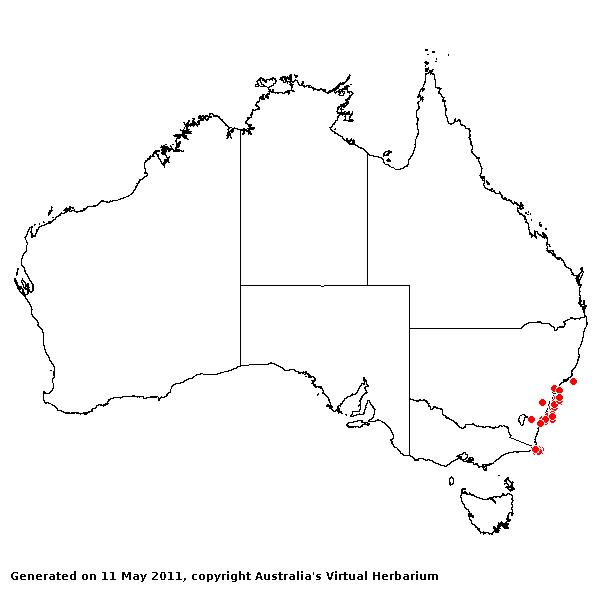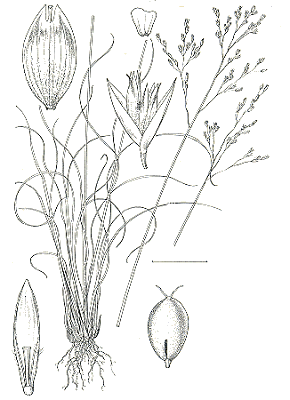Plinthanthesis paradoxa (R. Br.) S. T. Blake. Contr. Qd Herb. 14: 3 (1972).
Classification. (GPWG 2001) : Subfamily
Danthonioideae. Tribe Danthonieae.
Basionym and/or
Replacement Name: Danthonia
paradoxa R. Br., Prodr. 177 (1810).
Type of Basionym or
Protologue Information: HT: Brown 6230, Australia (BM; IT: K, MEL).
Key references
(books and floras): [1810]. R.Brown, Prodromus (177 as Danthonia
paradoxa), [1878] G.Bentham, Flora Australiensis 7 (591as Danthonia
paradoxa), [2002] D.Sharp & B.K.Simon, AusGrass, Grasses of
Australia, [2008] S.W.L.Jacobs, R.D.B.Walley & D.J.B.Wheeler, Grasses
of New South Wales (343).
Illustrations:
[1984] N.T.Burbidge. rev. S.W.L.Jacobs, Australian Grasses (219), [2005] K.Mallet (ed.), Flora of
Australia 44B: Poaceae 3 (Fig. 5, A-F), [2008] S.W.L.Jacobs,
R.D.B.Whalley & D.J.B.Wheeler, Grasses of New South Wales, 4th edn
(343).
Habit.
Perennial. Culms erect, 25–100 cm tall, 3–4 -noded. Mid-culm nodes glabrous.
Leaves mostly basal. Ligule a fringe of hairs, 0.5 mm long. Leaf-blades
filiform, convolute, 20–40 cm long, 2–3 mm wide. Leaf-blade surface scabrous.
Inflorescence.
Inflorescence compound, a panicle. Panicle lanceolate or pyramidal, 7–20 cm
long.
Spikelets.
Spikelets pedicelled. Fertile spikelets many flowered, with at least 2 fertile
florets (3–5), comprising 3–5 fertile floret(s), without rachilla extension,
oblong, laterally compressed, 4–9 mm long.
Glumes. Glumes
similar. Lower glume lanceolate, chartaceous, keeled, 1-keeled, 3–7 -nerved.
Upper glume lanceolate, 4–6 mm long, chartaceous, keeled, 1-keeled, 3 -nerved.
Upper glume surface asperulous.
Florets.
Fertile lemma 2–4 mm long, without keel, 9 -nerved. Lemma surface indumented.
Lemma apex lobed, mucronate or awned, 1 -awned. Median (principal) awn from a
sinus, 0.5–1.5 mm long overall, with a straight or slightly twisted column.
Palea 2 -nerved. Lodicules present. Anthers 3. Grain 1.5 mm long.
Continental
Distribution: Australasia.
Australian
Distribution: New South Wales, Victoria.
New South Wales:
North Coast, Central Coast, South Coast, Central Tablelands, Southern
Tablelands. Victoria: East Gippsland, Grampians, Lowan Mallee, Midlands,
Murray Mallee, Riverina, Volcanic Plain, Wimmera.
Notes.
There is some variation in this species in the development of the awn, which is
also the critical key character distinguishing it from the other two species in
the genus. Although P. paradoxa is morphologically close to P.
rodwayi, there are no intermediate collections. The characters by which
these two species are separated are given under P. rodwayi. However,
there are some intermediate collections between P. paradoxa and P.
urvillei. These are discussed under P. urvillei.
Extends
from the Blue Mountains south to the Gippsland border, altitude 0–200 m, in
marshy habitats on sandy or peaty soils, often along the coast in coastal heath
over sandstone. Flowers Nov. to Dec.




